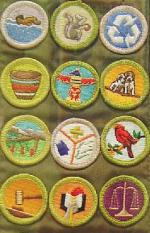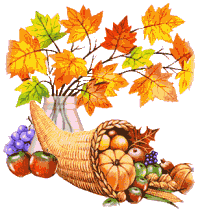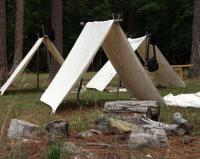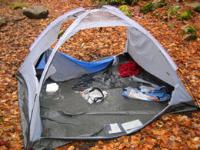Scoutmaster Musings
Archives:
2023 2022 2021 2020 2019 2018 2017 2016 2015 2014 2013 2012 2011
2010 - Dec Nov Oct Sep Aug Jul Jun May Apr Mar Feb Jan
2009 2008 2007 2006 2005
Top 10 Useful Merit Badges
 The majority of the over 125 active merit badges introduce scouts to skills, careers, and hobbies which have little to do with Scouting. The goal of the merit badge program is to broaden a scout's experience, not just to improve his scouting skills, and that's why we have Coin Collecting, Dentistry, and Truck Transportation merit badges. They allow scouts to take a different path on the Boy Scout trail.
The majority of the over 125 active merit badges introduce scouts to skills, careers, and hobbies which have little to do with Scouting. The goal of the merit badge program is to broaden a scout's experience, not just to improve his scouting skills, and that's why we have Coin Collecting, Dentistry, and Truck Transportation merit badges. They allow scouts to take a different path on the Boy Scout trail.But, what about those Scouting Skills? Once a scout reaches First Class, does he stop using those skills he demonstrated to earn rank? In many cases, the answer is 'Yes'. Tying knots, performing first aid, and using a map and compass are not activities that occur very often in the everyday life of a scout. Fortunately, some of the merit badges specifically build on scouting skills so scouts can continue to develop their outdoor abilities.
These merit badges are the most useful to help scouts keep their skills strong:
- Backpacking - builds on their camping skills and expands from simple weekend campouts. Great to include in Philmont preparation.
- Camping - promotes more planning and preparation, and requires more camping and cooking experience.
- Cooking - promotes varied and healthy cooking. A good merit badge for scouts planning their own high adventure trip.
- First Aid - almost all 'explain' and 'describe' requirements. Completion of the Red Cross Wilderness and Remote First Aid course pretty much covers all the requirements.
- Hiking - gets scouts out on the trail. I'd say this is the best badge for getting in shape and it's an obvious choice to include in Philmont preparation.
- Orienteering - great exposure to more map and compass skills, crucial for high adventure treks.
- Pioneering - additional knots and lashing work, culminating in a full-scale project planned and executed by the scout.
- Swimming - expands on the First class requirements. A good pre-trek requirement for Sea Base.
- Weather - helps scouts understand how weather happens so they can be more prepared on adventures. This is one area not really covered in rank advancement.
- Nature/Bird Study/Mammal Study/Insect Study/Reptile & Amphibian Study - more exposure to the natural world after the 10 animals and plants requirements.
You could encourage scouts to do these merit badges as a way to build the overall skill level in a troop. Creating a Scout Challenge that includes these badges might be a good incentive.
Scout On
| Leave Comment |
Posted: 15:59 11-30-2010 539
10 Things I'm Thankful For
 Everyone has their gizmos, gimmics, gadgets, and gear that they wouldn't leave home without. When it comes to Scouting, here's a few things that I'm thankful exist and why:
Everyone has their gizmos, gimmics, gadgets, and gear that they wouldn't leave home without. When it comes to Scouting, here's a few things that I'm thankful exist and why:- Gore-tex - for helping us enjoy camping in the rain
- Victorinox - for making a high quality knife
- Ferrocerium - for making it possible to have sparks any time
- Dutch Ovens - for showing scouts you can cook real food outdoors
- Digital Cameras - for making instant, free memories possible
- Guyot Designs - for imaginitive, innovative products like squishy bowls, firefly light, and splashguards
- Raccoons - for teaching more scouts the value of securing food than all other animals combined
- Tentpole Clips - for saving thousands of minutes that would have been wasted sliding tentpoles through sleeves.
- Polar Fleece - for warmth in all it forms; hats, jackets, balaclavas, pants - everything but snuggies.
- Scout Challenge - for providing an incentive for older scouts to stay active in regular troop stuff.
Scout On and Happy Thanksgiving!
| Leave Comment |
Posted: 11:56 11-24-2010 538
Top 10 Training Topics
 I expect you've heard the talk of mandatory training for scout leaders coming along. I suppose that's probably really the only way to make it happen - make it required. I'm happy that all but 1 of the Assistant Scoutmasters in our troop have their Trained patch. That's 1 out of 16, and he's just got one more session to complete.
I expect you've heard the talk of mandatory training for scout leaders coming along. I suppose that's probably really the only way to make it happen - make it required. I'm happy that all but 1 of the Assistant Scoutmasters in our troop have their Trained patch. That's 1 out of 16, and he's just got one more session to complete.That's just the basic training required to wear the Trained patch. There's a lot of other Coaching that I'd recommend all adult leaders take to improve the safety and success of their unit activities. It shouldn't be taken because it's required for a patch or to do a tour permit - it should be because you want to be as prepared as possible for anything that may happen.
Here's 10 to consider:
- WRFA - Wilderness and Remote First Aid provides leaders exposure to handling emergencies while out scouting. Whether it's a weekend campout or 10-day Philmont trek, this training is vital knowledge. At least two adults on every outing should have this training.
- CPR - Heart problems can occur in adults at any time, whether hiking or at a troop meeting. All adults and youth over 14 should know how to do CPR and be exposed to AED usage.
- Youth Protection (online) - It's mandatory for all BSA volunteers and is designed to help you keep our youth safe from abuse. You will learn the Boy Scouts of America's Youth Protection Guidelines, signs of abuse, and how to report suspected abuse. Every adult that interacts with youth should take it every two years. Required for 'Trained' patch and Scout Leader's Training award.
- Intro to Outdoor Leader Skills - Introduction to the tenderfoot, 2nd class, and 1st class scouting skills so adults can help scouts complete their requirements. It doesn't make sense for someone to sign off on a first aid or knot tying requirement if he doesn't know the skill well himself. All adults that teach or sign off should take it. Required for 'Trained' patch and Scout Leader's Training award.
- Scoutmaster Specific - Three sections to introduce scoutmasters and assistants to the workings of a Boy Scout troop. Good exposure for all parents, and required for 'Trained' patch and Scout Leader's Training award.
- Safe Swim Defense (online) - Learn the safety guidelines for all water activities in the BSA. All swimming activities in Scouting are required to follow the eight principles known collectively as the Safe Swim Defense plan. A unit that follows the plan can expect a safe, enjoyable aquatic experience. Safe Swim Defense is required for BSA tour permits.
- Safety Afloat (online) - Learn the safety guidelines for boating activities in the BSA. All boating activities in Scouting are required to follow the nine principles of Safety Afloat. With an emphasis on accident prevention through proper preparation and skills, a unit that follows Safety Afloat can expect a safe, enjoyable activity. Safety Afloat is required for BSA tour permits for any trip afloat. /li>
- Trek Safely (online) - Learn how to safely plan and lead a high adventure trek using the BSA guidelines. Covers seven key safety points about trekking and is recommended for adult leaders organizing any type of trek. You will watch a brief video broken into two sections and answer questions after each section.
- Climb On Safely (online) - Learn the BSA climbing guidelines. Covers eight key safety points about climbing and rappelling and is recommended for adult leaders organizing any type of climbing outing. You will watch a brief video broken into three sections and answer questions after each section.
- Weather Hazards (online) - Learn to plan for bad weather and make good decisions when you are out in it. Must be completed prior to requesting a tour permit from the BSA. The module presents safety precautions for eight different types of weather, as well as planning, preparation, and traditional weather signs.
There are also a bunch of Supplemental Training Modules at scouting.org that cover specific topics.
Scout On
| Leave Comment |
Posted: 22:55 11-19-2010 537
One Match Fire
 How many matches does it take a Boy Scout to light a fire? I've seen it done with 58 matches - seriously! But, it really should just take one match. Preparing the fire lay is important, but so is lighting the match.
How many matches does it take a Boy Scout to light a fire? I've seen it done with 58 matches - seriously! But, it really should just take one match. Preparing the fire lay is important, but so is lighting the match.There are better and worse ways to light a match. Many people hold with index finger and thumb and strike away, using the thumb to apply most of the friction pressure. First off, this puts a lot of stress on the thin matchwood which results in often broken matches. It also puts the match tip up and out in the wind where it more often than not goes out right away. Finally, it promotes thrusting the match into the tinder immediately, with just the chemicals flaring and before the match wood has started to burn.
Consider trying this method instead:
- Hold the match like writing with a tiny pencil
- Place your index finger and thumb up by the butt of the match, rather than the head
- Place your middle finger close to the head of the match
- Use your middle finger to put pressure on the matchhead to box
- Strike the match towards you rather than away from you
- Let the matchwood start burning before placing the match in your fire.
Placing your middle finger close to the head greatly reduces the chance of breaking the match. Since it is not used to hold the match, you can easily move it away when the match lights. After the striking motion, the match is left held between your index finger and thumb with the match head down and cupped in your hand, protected from wind. In this position, you can give the match wood time to catch and then light your prepared fire.
Scout On
| Leave Comment |
Posted: 13:24 11-18-2010 536
Got a Minute?
I'm working on a scout challenge project and would like to know which stock patch emblem is most popular. Select your favorite at This Page - it just takes one click.
Thank you
Thank you
| Leave Comment |
Posted: 10:47 11-16-2010 535
Top 10 Cheap Recruiting Tips
 There are many things you and your scouts can do to promote your troop to prospective new scouts that don't require a huge effort or expense. If your troop is hoping to grow, think about giving these tips a try:
There are many things you and your scouts can do to promote your troop to prospective new scouts that don't require a huge effort or expense. If your troop is hoping to grow, think about giving these tips a try:- Eagle Scouts - Tell Webelos den leaders you have two Eagle Scouts that would love to visit a November or December den meeting and answer questions about Boy Scouting, not to promote your troop. If you have no Eagles, go with Life Scouts. Make sure they wear their uniforms, sashes, high adventure patches, and take other mementos from their adventures.
- Communicate - Call the Cubmaster and Webelos den leaders in May to let them know what you have planned for their scouts in the fall to help with Arrow of Light and transitioning. Call them again in September to remind them, make sure you still have the correct contact, and ask how many scouts they have in their dens.
- Scout Skill Day - A scout-o-rama is a great way to show Webelos some fun scout skills and impress their parents and den leaders. It doesn't have to be a big deal, but does take some planning effort.
- Pinewood Derby - offer to help with running the races, moving cars, anything they need on that one day.
- Special Awards - Our council has a Summit Achievement Award for scouts that earned the Arrow of Light, joined a troop, and did a few other requirements. Check if your council has any special awards for Webelos and promote them to the dens so they are aware.
- Open Troop Meetings - Invite Webelos to visit any troop meeting in the fall.
- Catch One Early - If you get one Webelos scout to commit to join your troop early in the fall, chances are good that many of his den mates will follow him, especially if he lets them know where he's going.
- Twofers - When a Webelos decides to join, or when he has his scoutmaster conference for the Arrow of Light award, let him know that this is the perfect time to have a non-scouting buddy join him in Boy Scouts. He can get a Recruiter strip if he gets a friend to join with him.
- Den Chief - This one does take a big effort on the part of one scout, but it is also a troop Position of Responsibility for advancement. In May, help one of your First Class scouts decide to be a Den Chief for a 5th grade Webelos den from October to March. This gives the Webelos contact with your troop right up to their transition from Pack to Troop. And, he might continue on as a Troop Guide for the next 6 months.
- Use Roundtables - Make an effort at every district roundtable meeting to look for and say "Howdy" to the leaders of the Packs in your area. It's easier to send their scouts to someone they know than just to a troop number.
Read more transition tips.
Got any more to share?
Scout On
| Leave Comment |
Posted: 8:52 11-07-2010 534
Top 10 Tent Tips
 Our troop has 32 tents currently in service. With 80 scouts in the troop, I've had lots of opportunity to see how tents wear out, break, or get damaged. Sometimes it is due to nature, other times it is neglect, and on rare occasion it is malicious.
Our troop has 32 tents currently in service. With 80 scouts in the troop, I've had lots of opportunity to see how tents wear out, break, or get damaged. Sometimes it is due to nature, other times it is neglect, and on rare occasion it is malicious.We need to remember that learning is our goal, not perfection. When a person is first learning to do something, he makes mistakes and equipment can take a beating. Teaching how to use equipment will save a lot of money, hassle, and frustration along the way. Teaching early and reminding often for the first few campouts will help the learning become habit.
Here's my Top 10 Tent Tips to help extend the life of your troop tents, the more important first:
- Mind the Door - When entering or leaving the tent, always open the zipper almost all the way, but not all the way. Opening just a crack and squeezing through is the biggest cause of tent damage I've seen. The stress on the zipper causes failure which is impractical to fix. Opening it all the way causes failure at the end of the zipper.
- No Clutter - The best way to keep a tent floor intact is to keep gear outside. Pulling gear in and out through the door is hard on the zipper and fabric. If the tent has a vestibule, that is fine for items you'll need during the night or first thing in the morning, such as boots and raincoat, but packs covered and kept outdoors are even better. Teaching this one behavior to scouts is probably the one best way to improve their tenting experience.
- Clean and Dry - After every use, turn the tent inside out to get everything out and wipe it clean. Set it up to dry completely and then pack it away. Store it in a dry area. This prevents mold and mildew.
- Complete Setup - Poles break because stress is not evenly distributed. Ensure all clips, sleeves, velcro, guy lines, and hooks are connected correctly, completely, and sturdily. Leaving a couple velcro straps unhooked during high wind places increased pressure on single spots on the poles instead of spreading it out and SNAP! A broken pole instantly makes a hole in the rainfly.
- Use a ground sheet - This protects the floor from the outside, mostly from the dirt. A ground sheet is just a cheap piece of painter's 6mil plastic. It comes in 8.5 foot side rolls, so it's simple to slice off a piece for a 2-, 3-, or 4-man tent's width. Have scouts request a new piece from the quartermaster when their piece is too ripped to continue.
- Be Consistent - Always leave the zipper in the lower-right corner of the door if it is a double zipper, or the lower-left if it is a single zipper. It makes it easier to find and ensures the door gets opened fully each time.
- Store the Bag - When setting up, put the stake bag and pole bag inside the tent bag immediately. Bags blowing away is an all too common waste of gear. Store the bags inside the front-right corner of the tent - it's easy to get to and consistently easy to find.
- Mind the Wind - Set up your tent to protect it from wind. The rainfly on an A-frame style tent makes a great kite when the wind blows directly at an end. Instead, set up so a side is facing the wind. A dome-style tent with full rainfly to the ground can weather very strong winds and it doesn't matter much which way the wind hits it. Be sure to stake down all points and use the longer, higher guy lines at least on the upwind side for that bit of extra support to protect the poles.
- Seal It, Tape It - Using a seam sealer annually will help keep the rain out. Duct tape on both the inside and outside of holes and tears works well. Colored duct tape is available so the silver won't stand out so much. Higher quality tape stays much better and doesn't fall off leaving a gooey mess.
- No Fires - never, ever, ever have fire inside a tent. That's candles, stoves, matches, any flame.
 A couple more tips:
A couple more tips:- Know how to set up, use, and take down your tent before ever stepping into the wilds. Teach and practice the right way to use the tents before scouts go on their first campout. Friday night, in the dark, fighting the wind and rain, is not the time to learn how to set up the tents.
- Stakes don't usually break, but they get lost all the time. Painting a couple stripes of bright colored nail polish on each one makes them much more visible when breaking camp. If they have been driven into the ground, the only part you'll see is the head, so painting it bright is key.
- No matter how well you take care of your tent, an animal can destroy it easily. Having any food or smellables in your tent is inviting disaster, and much more than just a ruined tent.
You should strive to create an environment in your troop where experienced scouts understand the value of maintaining their gear and passing that understanding on to newer scouts. Having a couple Instructors or Troop Guides or Eagle Scouts teach these ten tips to new scouts as soon as they join the troop will do wonders for your budget and quality of camping experience. If it's just the scoutmaster lecturing them about how expensive tents are and how they have to use their tent for seven years and blah, blah, blah, ... there's not nearly the impact.
Do you have other tips about tent use to share? comment away.
Scout On
| See 1 comment | Leave Comment |
Posted: 15:52 11-05-2010 533
Previous PostsComments:
Feb 25, 2023 - Joe Patterson
Just out of curiosity, are the Rockwell paintings on exhibit anywhere
Mar 16, 2023 - Adam John
Great question Joe! Have you checked out the Norman Rockwell Museum in
Stockbridge MA? (nrm.org) There is also the Rockwell Museum in Corning
NY. (rockwellmuseum.org) I believe the latter has more art. Hope this
helps!
Jan 21, 2024 - Johnna Downing
The Scouting museum at Philmont, Cimmaron, NM hopefully has the ones that
used to hang at the museum in Irving, TX. Good luck. Johnna
Scouting 2024 - Ask a Question - Add Content
Just for Fun: Socializing merit badge




This site is not officially associated with Scouting America
Find more Scouting Resources at www.BoyScoutTrail.com



Follow Me, Scouts
Recent Comments